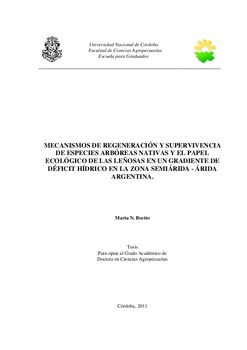| dc.contributor.advisor | Barchuk, Alicia Haydeé | |
| dc.contributor.author | Boetto, Marta Noemí | |
| dc.date.accessioned | 2017-03-31T18:40:07Z | |
| dc.date.available | 2017-03-31T18:40:07Z | |
| dc.date.issued | 2011 | |
| dc.identifier.uri | http://hdl.handle.net/11086/4643 | |
| dc.description | Tesis (Doctor en Ciencias Agropecuarias)--UNC- Facultad de Ciencias Agropecuarias, 2011. | es |
| dc.description.abstract | Aspidosperma quebracho-blanco y Prosopis flexuosa, árboles de estrategias foliares
contrastantes, se distribuyen en un amplio gradiente de disponibilidad hídrica, en la zona
central de Argentina, más allá del límite establecido por las lluvias. Su establecimiento
inicial es facilitado por plantas nodrizas en el noroeste de la provincia de Córdoba, pero se
desconoce si la intensidad de esa interacción y el mecanismo implicado, cambia conforme
lo hace el déficit hídrico. Se estudió el papel de especies leñosas como facilitadoras de la
regeneración natural y el mecanismo involucrado en la supervivencia de bancos de
juveniles de ambas especies. Los sitios de trabajo se ubicaron en una transecta regional que
corresponde a un gradiente de déficit hídrico (desde 100 a 800 mm/año). Al caracterizar las
comunidades leñosas en base a tipos funcionales de plantas (TFP) potenciales nodrizas, se
encontraron 11 grupos diferentes, diferenciados por rasgos que definen su oferta de sombra
y la formación de islas de fertilidad. En el gradiente, los TFP variaron por
presencia/ausencia o cambios de abundancia relativa de alguna especie componente. A
pesar de la heterogeneidad del ambiente, se demostró la facilitación a una escala que
equivale a la cobertura del individuo arbustivo, por ausencia de asociación espacial entre
los vacíos ecológicos y los juveniles de A. quebracho-blanco y P. flexuosa y confirmación
de asociación espacial positiva entre los mismos juveniles y arbustos microfilos
caducifolios leguminosos y perennifolios no leguminosos. La intensidad media de las
asociaciones de A. quebracho-blanco incrementó en función del déficit, mientras que la de
P. flexuosa se mostró más laxa en ambos extremos de su distribución. Los experimentos de
nodricismo demostraron que el mecanismo más importante para la regeneración natural de
A. quebracho-blanco es la sombra, mientras que para P. flexuosa cambia en el extremo
más árido de la transecta. Se registró menor acumulación de biomasa en los juveniles bajo
sombra, como evidencia de interferencia sobre el crecimiento. En síntesis, la importancia
de la facilitación incrementa junto con el estrés ambiental originado en el déficit hídrico.
La interferencia domina en el extremo de mayor disponibilidad de agua. | es |
| dc.description.abstract | Tree species of leaf contrasting strategies, such as Aspidosperma quebracho-blanco and
Prosopis flexuosa, are distributed over a wide gradient of water availability in the central
region of Argentina. Both penetrate into arid regions. Initial establishment is facilitated by
nurse plants in the northwest of Cordoba, but it is not known whether the interaction
intensity and the involved mechanism change as the water deficit increases. Both the role
of woody species as facilitators of natural regeneration and the involved mechanism in the
survival of juvenile banks of both species were studied. The workstations were located in a
regional transect in central Argentina, which corresponds to an annual water deficit
gradient (from 100 to 800 mm/year). Woody communities were characterized on the basis
of functional types as potential nurse-plants (TFP). Eleven groups were differentiated by
traits that define their shade and the formation of fertility islands. In the gradient, the TFP
varied according to presence/absence or changes in the relative abundance of component
species. In spite of the environmental heterogeneity the existence of facilitation was
demonstrated at a scale corresponding to the coverage of individual shrubs based on the
absence of spatial association between open sky microsites and the A. quebracho-blanco
and P. flexuosa juveniles and the confirmation of positive spatial association between the
juveniles and the microphyll shrubs, both deciduos-Fabaceae and non Fabaceae evergreens.
The medium intensities of the A. quebracho-blanco associations were intensified in
keeping with the water deficit. Spatial associations of juveniles of P. flexuosa with other
woody plants were less intense in the gradient ends. Nodricism experiments showed that
the most important mechanism of A. quebracho-blanco for natural regeneration was shade.
Mechanism of natural regeneration of P. flexuosa changes in the most arid distribution
borders in the gradient. Smaller biomass accumulation in the shaded juveniles was
recorded as evidence of interference in growth. Summing up, the importance of facilitation
increases with environmental stress caused by water deficit. Interference predominates with
greater water availability. | en |
| dc.format.extent | 181 h. : il. col. | es |
| dc.language.iso | spa | es |
| dc.rights | Atribución-NoComercial-SinDerivadas 2.5 Argentina | * |
| dc.rights.uri | http://creativecommons.org/licenses/by-nc-nd/2.5/ar/ | * |
| dc.subject | Ecología vegetal | es |
| dc.subject | Facilitación | es |
| dc.subject | Regeneración natural | es |
| dc.subject | Disponibilidad del agua | es |
| dc.subject | Especies nativas | es |
| dc.subject | Árboles | es |
| dc.subject | Zona árida | es |
| dc.subject | Zona semiárida | es |
| dc.subject | Argentina | es |
| dc.title | Mecanismos de regeneración y supervivencia de especies arbóreas nativas y el papel ecológico de las leñosas en un gradiente de déficit hídrico en la zona semiárida - árida Argentina | es |
| dc.type | doctoralThesis | es |





